Huge oil rush overruns the little known North Dakota landscape that was once the gateway to the west for Lewis and Clark. Update.
© 2013- 2016 Gary Braasch and Joan Rothlein.
(This photo story was first published by The Daily Climate on February 5, 2014. Major points of the introductory text have been updated as of January 2016 Dr. Joan Rothlein and Gary Braasch traveled across western North Dakota in the fall of 2013 to gather this photo story and background.)
In the spring of 1805 Lewis and Clark and their expedition paddled up the Missouri River into its middle valley, a land unknown to Americans then and still little known today. In addition to 30 crewmen, they now had two interpreters, Touissant Charbonneau and Sacagawea with her infant son, Baptiste. As they worked their two pirogues and six dugout canoes against the current along the river’s deep meanders, the party was presented with a dramatic panorama, as Meriwether Lewis would write in his Journal on April 25, 1805:
“I ascended the hills from whence I had a most pleasing view of the country, perticularly of the wide and fertile vallies formed by the missouri and the yellowstone rivers, which occasionally unmasked by the wood on their borders disclose their meanderings for many miles in their passage through these delightfull tracts of country. “
After Lewis and Clark returned home, the Mandan and Minitaris (Hidatsas) natives and other tribes whose shelter and information made the expedition a success suffered greatly from disease and Army invasions of this natural paradise. By 1881 the region had become Dakota Territory. North Dakota, made a state in 1889, was settled by white ranchers and farmers growing wheat and sugar beets. The Corps of Engineers blocked the Missouri with Garrison Dam in 1952, inundating the valley in which Lewis and Clark had paddled toward the confluence of the Yellowstone.
Also in the 1950s, oil was also discovered just north of the Missouri River near Tioga ND. At first this was not a boom – it took more than five years to develop just 10 wells in North Dakota’s Bakken shale formation. There were only 1000 in 2009. But the current boom more than lives up to its name, thanks to hydraulic fracturing, which cracks the shale and allows sweet crude to flow much more easily. The Bakken now has more than 8600 wells, North Dakota as a whole 11,500, and the state is adding up to 300 each month. The Bakken is the largest oil formation in the U.S. and had been producing a million barrels a day since mid-2014 – double the rate just two years before — but now with oil prices tanking, pumping and new well drilling are slowing down as the oil industry retrenches.
This oil rush, involving international oil firms, runaway population growth, infrastructure shortcomings and disruption of the peace in what had been mostly empty agricultural country, created major social, labor and financial change. And in a classic boom and bust, the reduction in oil operations has emptied out new motels and worker camps and reduced income for businesses that just expanded to meet the previous demand.
Getting the product to refiners, has also been a challenge. The main route out of the Bakken is via rail tank cars, but concerns about the safety of rail transport abound, ignited by a fatal tank car disaster in Lac-Megantic, Quebec, July 2013, that killed 47 and by a December 2013 crash in North Dakota that forced almost 2,400 people from their homes. With the Bakken's growth have come increased public hearings and protests over fossil fuel rail traffic across the West. Oil producers and refiners are proposing 15 new or expanded oil ports and refineries in the Northwest, mostly to handle up to a million barrels a day of Bakken crude. For more on this, please see Sightline.
For updates on some of the shifting economic issues of the oil boom and falling oil prices, please see this NY Times article.
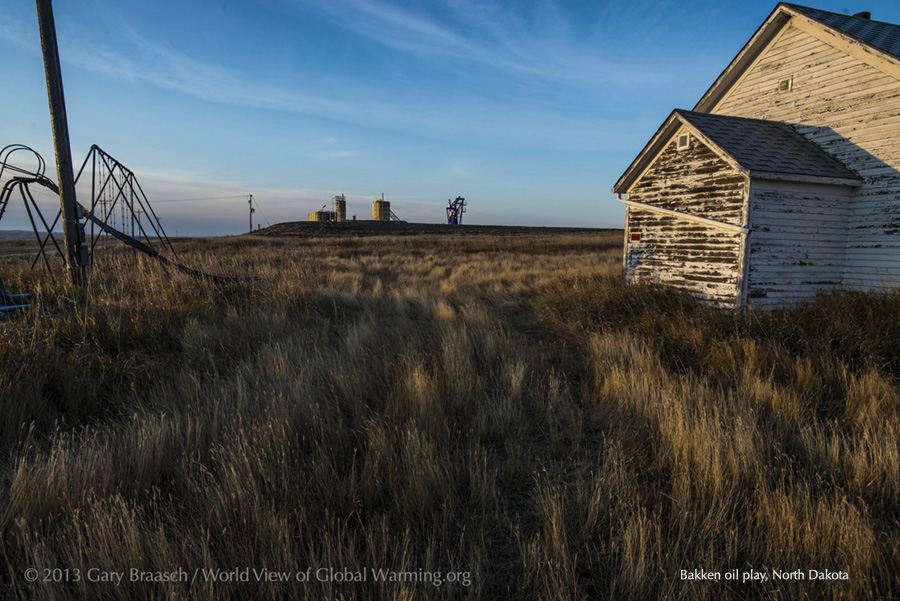
Time and changes on the prairie. An abandoned school near Williston ND is neighbor to an active oil well, symbolizing the economic boom which has brought industrial development and pollution threats to a once quiet rural region of the upper Midwest. Ranchers said that in response, some older residents are leaving. Other people are making money, taking petroleum jobs, leasing oil sites and selling freshwater needed to make fracking fluid and maintain the active wells. And still other North Dakotans are giving voice to environmental concerns.
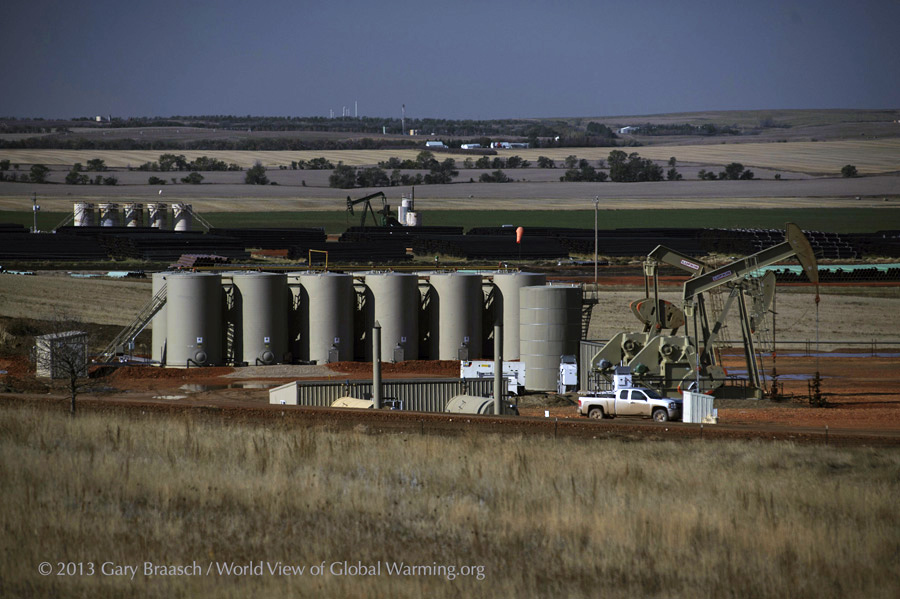
At least five oil well sites line this county road west of Williston ND and continue into the distance. Red scoria gravel drill pads are being laid down one after the other at a rate of 200 more each month. Access for this is frequently along new roads built every half section that ranchers say are cutting through prairie which had never been roaded. The Bakken shale formation extends under about 15,000 square miles of western North Dakota and parts of Montana, Saskatchewan and Manitoba. Total untapped reserves estimated by the USGS: 7.4 billion barrels of oil. Wells cost about $9 million to complete and petroleum engineers expect a 30-45 year flow of oil. Some analysts say Bakken wells are economically sound with oil prices above $70/barrel, which it has been through most of the boom. But the market for crude is crashing worldwide, and the price is sliding below $50 a barrel. Some companies are suspending work on new wells in 2015
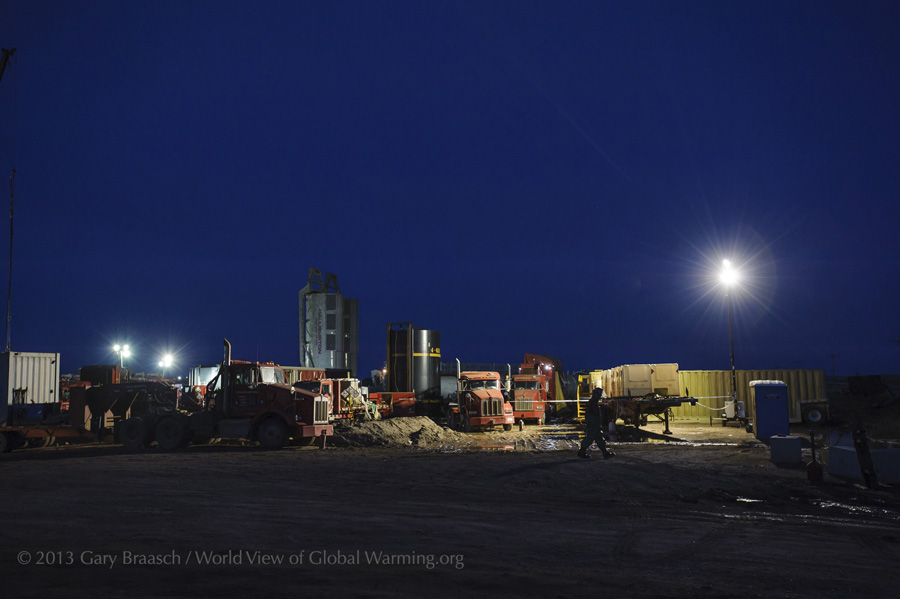
Trucks, tanks and 24-hour work at a new well site where fracking with treated water and fine sand will open the shale via lateral drilling in multiple directions. Two to three million gallons of water are used per well, according to North Dakota Department of Mineral Resources, and three million pounds of sand. But continuous need for washing out salty drilling water means wells during their life may use more than three times the initial amount of freshwater, and will create about three times more brine than oil. Most of this water, called “produced water” in the oil business, is trucked away from oil wells and pumped into 400 disposal wells which are drilled to keep the brine trapped in rock layers away from freshwater sources. This very salty water, may put huge additional pressure on aquifers and drinking water wells if it spills. The Bismarck Tribune reported on a 1 million gallon leak of brine in July 2014 that killed grass, bushes and trees along a 2 mile flow. North Dakota does not require fresh water testing during oil drilling to be able to gauge drilling's effect on ground water. The Bismarck paper also reported that tests on one aquifer recently by Federal scientists found no evidence so far of shallow groundwater contamination.
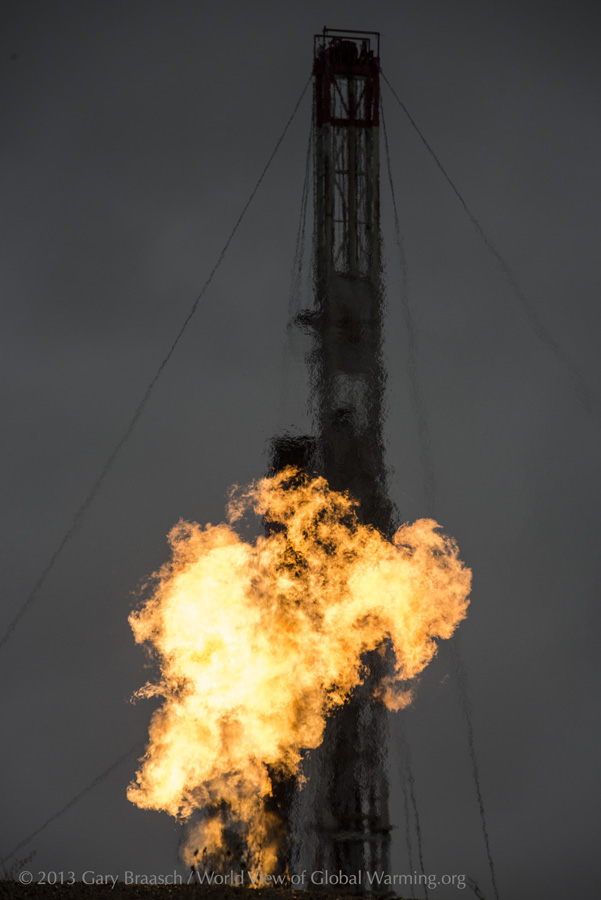
The high-decibel, screeching roar of this gas flare blasting from a pipe at an oil well is repeated at more than 1,500 wells across the Bakken – throwing off enough light to be seen from orbiting satellites. Oil companies are given much leeway to burn off this mostly-methane gas because there is capacity to capture and process only about two-thirds of it. Three times more gas is flared now than three years ago. Oil companies are reportedly experimenting with on-pad gas compressors and processors to separate the butane and propane from the methane. There are plans to use natural gas as railroad fuel, in the manufacture of fertilizer and to impose more royalties on the gas to encourage its capture and use.
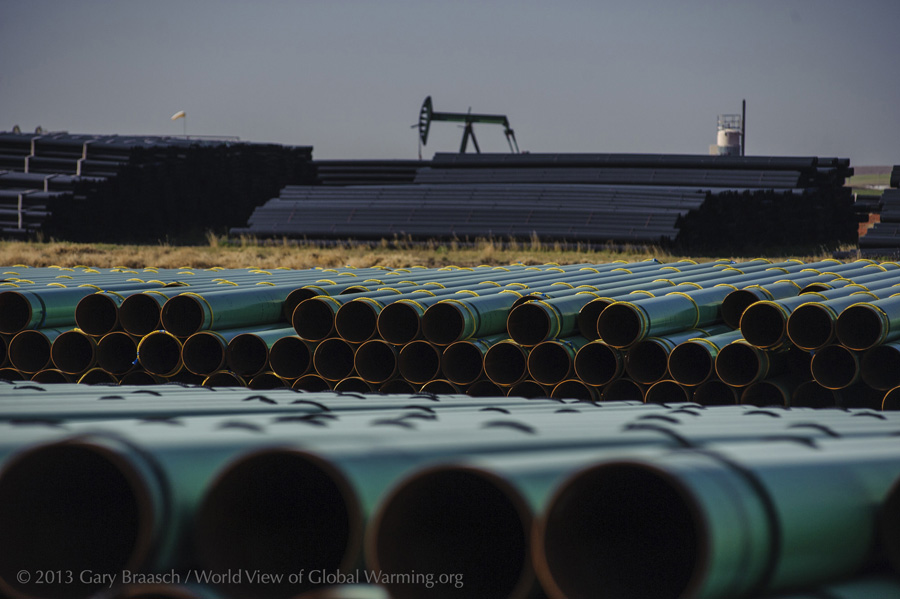
Stacks of steel pipe are ready to add to the almost 20,000 miles of petroleum industry pipelines in North Dakota. More than 2500 miles of pipeline are being added each year to capture methane, carry off waste water and transport oil. Huge questions about pipeline maintenance and oversight spurted into public awareness in 2013 when journalists revealed a 20,600 barrel crude pipeline spill in a wheat field north of Tioga, which went unreported by industry and state officials for 11 days. Health Department officials said no water or environmental damage had been caused. But the Associated Press went on to find 750 more small unreported leaks and spills since January 2012. The New York Times reported that close ties between the oil and gas industries and the North Dakota Industrial Commission which regulates the drilling and production of oil and gas, may contribute to a lack of transparency and strict enforcement of petroleum regulations. Through early October 2014, said the Times, companies reported 3.8 million gallons spilled, nearly as much as in 2011 and 2012 combined. The Times said the state relies on industry self-reporting and policing and rarely pursues formal complaints or strong fines.
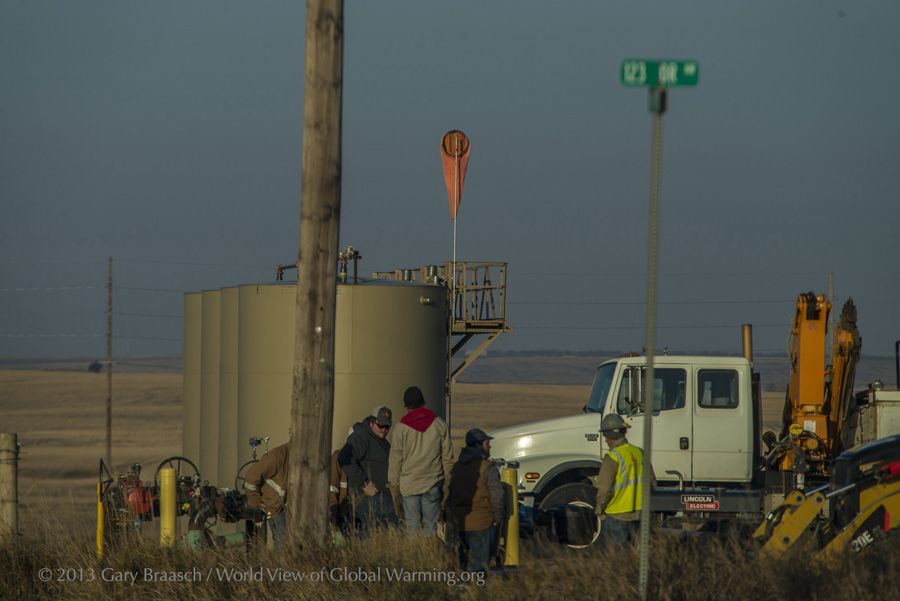
An oil boom is also a job boom. North Dakota has the lowest unemployment rate in the nation at 2.6 percent. Petroleum, engineering and construction workers are flooding into the Bakken for the high pay, and more than half the state’s employment growth in those jobs took place in Williams County (Williston). Although more than 10,000 jobs of all kinds have been added in the county since 2009, there are help wanted signs up at many service, retail, school and even health employers in Williston, according to the Oil and Gas Reporter. In 2011 Williston permitted more than twice the value in new buildings as did Fargo, which has six times the population. Williston is growing at more than eight percent a year.

“Agriculture ran our state forever. Now, it’s oil.” Out for an early evening meeting in a café, Renae Evensvold and Kristin Mesker are ranchers and farmers north of Tioga NC. Renae (left), a biologist who previously worked for the National Resources Conservation Service and the Fish and Wildlife Service, grows wheat and raises 300 head of cattle on 2000 acres with her husband and family. Kristin, here with one of her two children, co-owns 1500 acres with her husband and leases more pasture for their 500 cattle. “We have friends, neighbors and family working for the oil fields,” Renae said, including for some time, her husband. But the changes -- heavy traffic on the back roads, loss of nearby stockyards as oil drilling moves in, the smog and dust from roads and oil drilling, the threat from waste ponds and pits, the pressures on the schools from temporary worker families – have strengthened their environmental commitment. “The state is permitting things so fast and so furiously,” Renae said, “that there’s no way they can enforce regulations.”
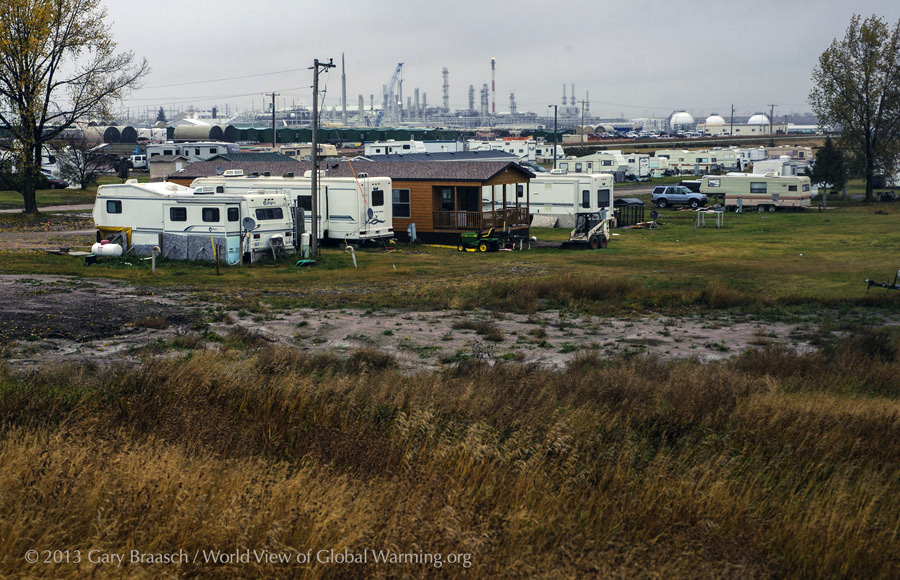
“No Vacancy.” In Tioga, Williams County ND, a trailer park spills over into a wetland in the shadow of a large Hess gas processing plant. Williston, the county seat, has surged from 12,000 to more than 20,800 population since 2006. Housing is tight and high priced, sewer and water systems are straining, and some communities don’t have enough restaurants or gas stations to serve the new residents. Many oil workers come alone and live in construction housing known as “man camps,” making it hard to know how many people are in the area. Environmental ranchers Renae Evensvold and Kristin Mesker think man camps are better than the more invasive permanent hotels and apartments springing up. But, says Kristin, “these are workers who take their money out of state.”
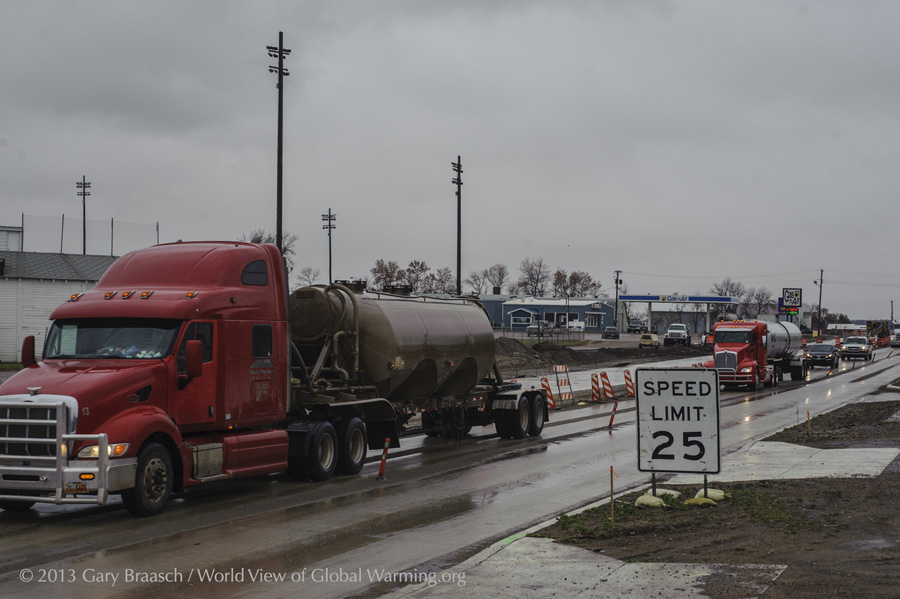
Tanker trucks and construction traffic backing up in the tiny town of Ray ND are another symptom of the Bakken oil boom. Heavy truck traffic has thundered in during the past four years to build and service more than 6600 wells. Each new oil rig site requires 2,300 round trips: Dumptrucks for gravel; 18 wheelers for supplies, water, waste, drilling mud, pipe, fuel, cement and oil; flatbeds for excavators and rig equipment – plus hundreds of work trucks and pickups. Rancher Kristin Mesker called driving the roads now “suicide,” and said traffic makes it harder to get her cattle to market. 270 miles of road were built or improved in 2013 just in the Williston area.
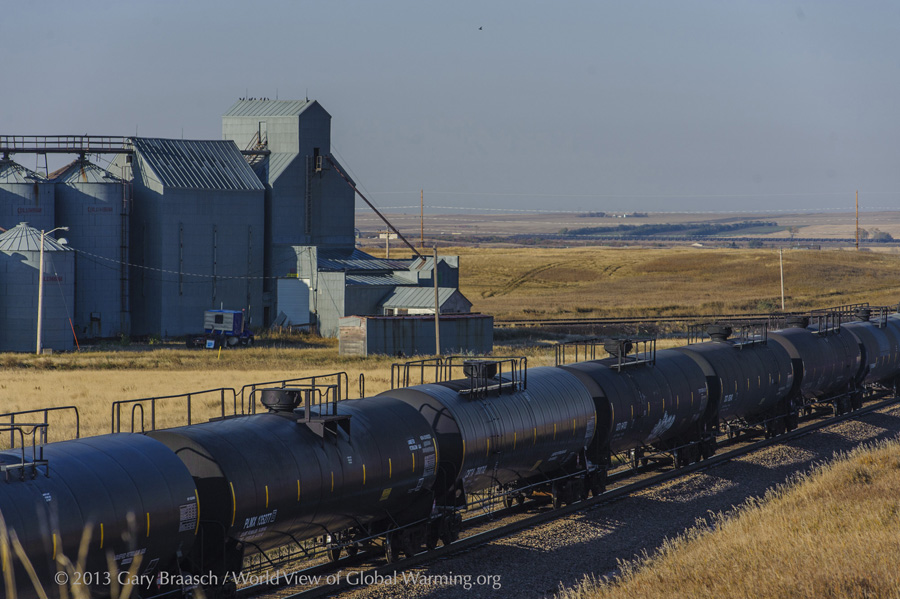
Epping is a tiny picturesque village of fewer than 100 people on a rail spur with some restored buildings housing a museum and a wheat elevator at the end of the street. But since Crestwood Midstream Partners' oil loading facility was built in just the last three years, long oil trains dominate the tracks rather than grain hopper cars. Ranchers feel the effects of so much oil shipping, according to Renae Evensvold, because when it is time to ship their wheat, “cars for wheat are slowed because oil cars have priority.” If elevator silos reach capacity because of a lack of wheat cars, then the farmers have to truck the wheat at additional cost of around 30c per bushel.
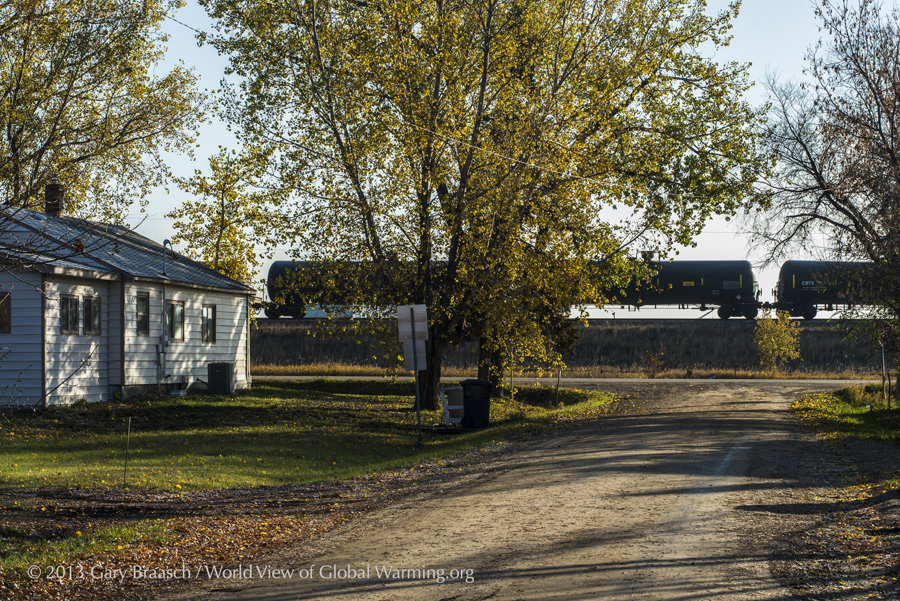
The new neighbors at the end of a very quiet street in Epping ND. In 2010, the oil loading area across the county road was just an open field. The entire facility – rail spurs, three crude oil storage tanks, and miles of 10-inch pipe – was built in this hamlet within the last three years. The oil facility can load 120,000 barrels of oil per day, about 230 tank cars worth. It's already scheduled for expansion. Regional railroads, principally BNSF, are on board with dedicated 100-car oil trains, the principal way that Bakken oil reaches refineries. More than 640,000 barrels a day of the crude were being pumped into rail cars this year across the region— two thirds of all North American crude rail shipments.
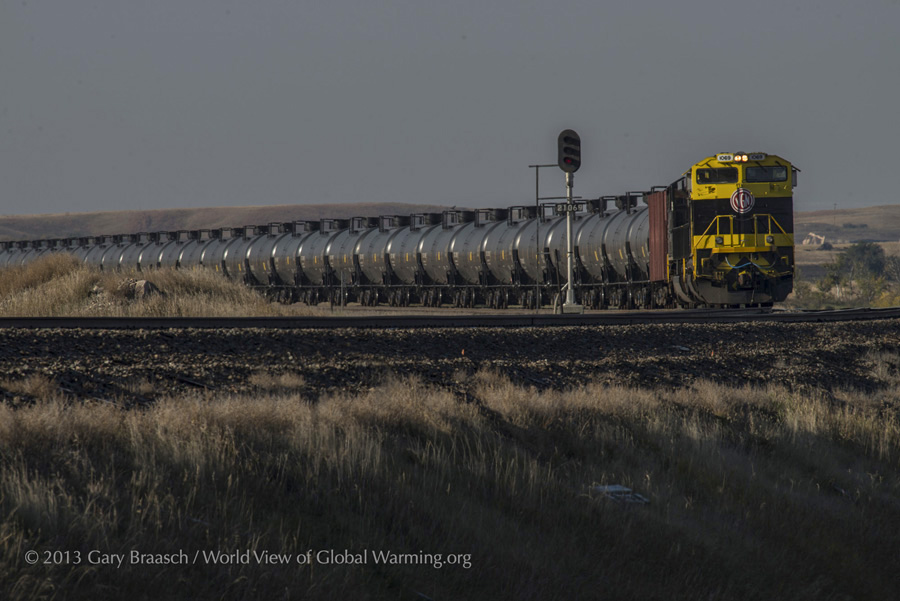
Tracking the future of energy transport and profits. The American Association of Railroads reports that nationally more than 800,000 railcars of oil were delivered in 2013 – up from only 11,000 in 2009. Most Bakken oil is going to refineries in the east and Louisiana; currently BNSF has reported it averages a little more than one train a day from North Dakota to Northwestern refineries. There are 11 proposals for Northwest coast ports and refineries which could accept more than 800,000 barrels a day of oil, which would mean about 15 100-car trains daily. The new oil port proposals are under study and public hearing process and being challenged by a coalition of environmental and health groups. In August 2014 the Federal Department of Transportation proposed rules that would require new oil tank cars constructed after October 2015 to have thicker steel and require retrofitting of existing tank cars. North Dakota’s Industrial Commission proposed to limit the amount of volatile gas in Bakken crude in an effort to reduce flammability of the oil in train wrecks.
These publications add background to the story of Bakken crude, oil train dangers, and the current American oil boom:
National Geographic: http://news.nationalgeographic.com/news/2014/12/141219-fracking-oil-supply-price-reserves-profits-environment/
Regional Sources: http://bismarcktribune.com/bakken/early-tests-don-t-find-tainted-water-from-oil-boom/article_57577e00-6e79-11e4-b5ce-836a79c2cc1f.html
http://www.thebakken.com/articles/948/until-oil-prices-recover-american-eagle-suspends-2015-plans
COPYRIGHT NOTICE:
Photography and text Copyright © 2005 - 2017 (and before) Gary Braasch All rights reserved. Use of photographs in any manner without permission is prohibited by US copyright law. Photography is available for license to publications and other uses. Please contact requestinformation@worldviewofglobalwarming.org. View more of Gary Braasch's photography here.


